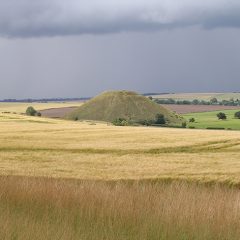ARCHAEOLOGISTS IN STONEHENGE BLUESTONE SHOCK
‘Got those Preseli Blues, everybody’s talkin’, ‘bout those Preseli Blues’ from Those ol’ Preseli Blues‘, recorded by Bettws y Smith, and the Bluestones (Paramount, 1923)
It appears you can get away with almost anything in contemporary archaeology. One can for once agree with Jacquetta Hawkes who reckoned that ‘Every generation gets the Stonehenge it deserves’. In this generation one may gain permission to dig the hallowed turf of Stonehenge itself provided you have a theory that is zeitgeisty enough to woo the public. But does it hold water?
I am, of course, talkin’ ‘bout my gg..g..g.eneration of archaeologists, the Geoffrey Wainwright Experience, with Geoffrey himself on Mediaphone, accompanied by Tim Darvill on Vibes. Their opening track? “Cutting the First Sods for 50 Years at Stonehenge”
Compared with anything that has gone before in recent Stonehenge history, this ‘New Improved’ theory of why the bluestones were so important to the builders of Britain’s National Temple must appear as pure affrontery to ‘the lunatic fringe of dotty archaeology’, who have always thought that, free from the dogma that lurks in academic disciplines, they had sole rights to investigate whatever questions they liked on archaeological matters. In an apparent surge of ‘if you can’t beat them, join them’ mainstream archaeology now boldly appears to be straying into traditional loony fringe territory. We must welcome them – they may be healed by the process. The media love it, of course, fawning all over the two heroes of this piece of Stonehenge ‘science’. It is the perfect media story. Stonehenge sells – and is thus like a magnet to the media. Everyone knows about Stonehenge (except they don’t really know very much about it at all), it’s a World Heritage Site and it attracts nearly a million visitors a year who all come, pay their £5, and then learn very little about it. Despite all this brouhaha, the monument retains its title as one of the best solstice detectors in the known world.
